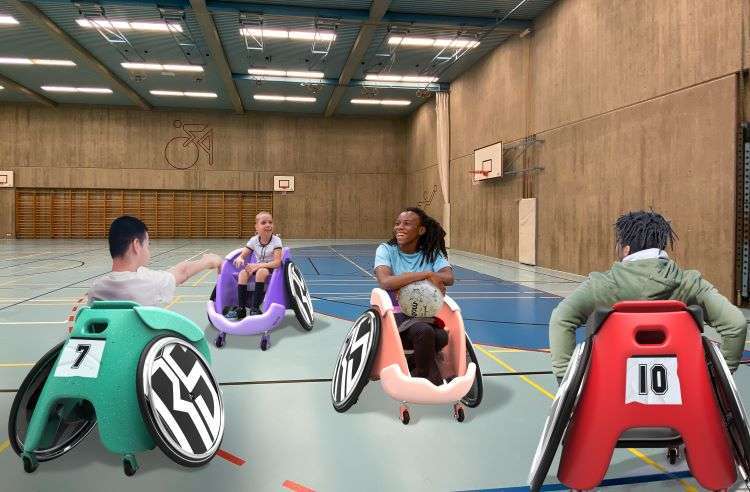Aston University and partners design “unique and low cost” rugby wheelchair

by IBRAHIM
Aston University and partners design “unique and low cost” rugby wheelchair

Designed for South African children aged 8-11, the wheelchairs are sustainable and expected to be locally manufactured.
Aston University product design experts have designed a “unique and user-friendly” rugby wheelchair for children in South Africa, which aims to be affordable.
The year-long project was funded by the British Council with the aim of connecting universities in different countries. Aston University senior lecturer in product, mechanical, and biomedical design and design engineering Dr Timothy Whitehead led the project along with Dr George Torrens from Loughborough University and Professor Deon de Beer from Central University of Technology in Bloemfontein, South Africa.
After receiving the funding and linking up with Central University of Technology, Whitehead explains that the next step was looking for “problems to solve”. He adds that this led the team to the wheelchair project and, during a visit to South Africa, they had to “try and understand the barriers” that wheelchair users in the country were faced with.
The main barriers were the import costs and the costs of the chairs themselves. According to Whitehead, there was also a gap in the market for wheelchairs aimed at 8–11-year-olds.
“Getting involved in a team sport is really beneficial for young disabled peoples’ physical and mental health, so it’s important that they can participate,” says Whitehead. He adds that the aim of the project was to make “a low-cost chair for people in low-income settings”.
The result is a wheelchair made from recycled HDPE plastic, inspired by Little Tikes, a brand of children’s toy cars. HDPE is the plastic typically found in bottle tops and Whitehead says that the team have a manufacturer in South Africa lined up that can carry out “the rotational moulding process” with this kind of recycled material.
He adds that “local manufacturing hubs” and cheaper materials are the solution to the cost problems. While cheaper, Whitehead says the plastic is still “durable” and the front bumper of the chair – the part which will experience the most impact – can be “detached and replaced”, giving the main shell of the chair a longer lifespan.
The wheels and “anthropometrics” of the chair, like wheel positioning, tilt angles, and height of the bumper and footrest, is in line with standard rugby wheelchair designs, Whitehead explains. However, the shape and styling are “unique to fit the brief” and the chairs are “stackable” once wheels are removed.
The material choice and colours also aim to make the chairs more “lightweight and friendly”, as research showed that female children were intimidated by the loud noises that the chairs made when colliding.
Due to the nature of the project and its partners, the design team are not claiming intellectual property “in a commercial sense”, meaning it is “effectively an open-source design”, says Whitehead.
Though the new wheelchairs will initially be made in South Africa, the long-term plan is that they will be made where required, which will help cut import costs globally. Whitehead says, “The only company which is manufacturing children’s rugby wheelchairs in South Africa is RMA, where equivalent youth rugby wheelchairs retail at £2455”, whereas Aston University’s target retail price is around £250. “This price point is based on the Little Tike cars as they require similar manufacturing processes”, he adds.
Whitehead reveals that the plan for the coming weeks is to 3D print a prototype in both the UK and South Africa for “static testing”. The first batch to undergo more rigorous physical tests is due to be produced in the next six months, with the designs being finalised within 18 months. Before mass manufacturing takes place, the rugby wheelchair designs will need approval from regulatory bodies as they are a “child’s product and a product with medical implications,” Whitehead adds.
Aston University also carried out a smaller scale project which involved making “design improvements” on adult wheelchairs meant to withstand rough terrain, says Whitehead. Made from tubular steel, the chairs can be used in the normal setting, or an extended wheel can be added to the front, as well as handlebars, that aid movement on bumpier roads.
He explains that the focus was on “quality control and repeatability” within the manufacturing process, which would result in “less user frustration” when the parts fit together as they should.
These chairs are also meant to be manufactured locally, in places where the level of quality control is limited and usually done in a rural setting. By “designing out errors”, the team “designed in specific manufacturing features which makes it hard to assemble it wrong”, says Whitehead.
These adult chairs have been prototyped and tested, and full production is now rolling out ahead of launch.
Recommended Posts

NB invites local designers centre stage for Vineyard Theatre rebrand
February 24, 2023

“AI revolution” will change way design studios look within three years
February 24, 2023

Rbl rebrands ZSL with ecosystem-inspired identity
February 23, 2023

